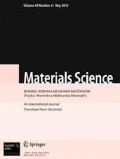For the quantitative analysis of fractographic images, we have used the method of segmentation of fractographic images by multilevel thresholding. In contrast to known approaches, to decrease the distortion of a segmented image, we took into account common features characteristic of not only its large components, but also small ones, to which low peaks correspond in the histogram of brightness. This has enabled us to separate an image of a fragment of a fracture surface into connected regions and then determine and analyze their quantitative characteristics.




Similar content being viewed by others
References
O. Z. Student, B. P. Rusyn, B. P. Kysil’, M. I. Kobasyar, T. P. Stakhiv, and A. D. Markov, “Quantitative analysis of structural changes in steel caused by high-temperature holding in hydrogen,” Fiz.-Khim. Mekh. Mater., 39, No. 1, 22–28 (2003); English translation: Mater. Sci., 39, No. 1, 17–24 (2003).
R. Ya. Kosarevych, O. Z. Student, Ya. D. Onyshchak, A. D. Markov, I. V. Ripei, B. P. Rusyn, and H. M. Nykyforchyn, “Estimation of damage to the collector of a water economizer by thermal fatigue cracks,” Fiz.-Khim. Mekh. Mater., 40, No. 1, 109–114 (2004); English translation: Mater. Sci., 40, No. 1, 132–138 (2004).
I. M. Zhuravel’, L. M. Svirs’ka, O. Z. Student, R. A. Vorobel’, and H. M. Nykyforchyn, “Automated determination of grain geometry in an exploited steam-pipeline steel,” Fiz.-Khim. Mekh. Mater., 45, No. 3, 23–29 (2009); English translation: Mater. Sci., 45, No. 3, 350–357 (2009).
R. A. Vorobel’, I. M. Zhuravel’, L. M. Svirs’ka, and O. Z. Student, “Automatic selection and quantitative analysis of carbides on grain boundaries of 12Kh1MF steel after operation at a steam pipeline of a thermal power plant,” Fiz.-Khim. Mekh. Mater., 47, No. 3, 109–115 (2011); English translation: Mater. Sci., 47, No. 3, 393–400 (2011).
C. D. Beachem, “Microscopic fracture process,” in: H. Liebowitz (editor), Fracture, Vol. 1, Academic Press, New York–London (1968), pp. 243–349.
O. M. Romaniv, Yu. V. Zyma, and H. V. Karpenko, Electron Fractography of Hardened Steels [in Ukrainian], Naukova Dumka, Kyiv (1974).
A. A. Shanyavskii, Safe Fatigue Fracture of Aircraft Structures. Synergetics in Engineering Applications [in Russian], Monografiya, Ufa (2003).
J. P. Bandstra and D. A. Koss, “On the influence of void clusters on void growth and coalescence during ductile fracture,” Acta Mater., 56, No. 16, 4429–4439 (2008).
K. Srinivasan, Y. Huang, O. Kolednik, and T. Siegmund, “The size dependence of micro-toughness in ductile fracture,” J. Mech. Phys. Solids, 56, No. 8, 2707–2726 (2008).
L. Jacobsson and C. Persson, “In situ scanning electron microscopy study of fatigue crack propagation,” Strength Mater., 40, No. 1, 146–149 (2008).
S. Cicero, R. Lacalle, R. Cicero, and J. Garcia, “Failure analysis of a steam generator superheater drain tube used in a dump,” Eng. Fail. Anal., 17, 301–312, (2010).
A. A. Shanyavskiy and Yu. A. Potapenko, “In-service fatigue fracture mechanisms in covered disks of a TV3-117VK helicopter turbine engine,” Strength Mater., 40, No. 1, 158–161 (2008).
M. Kowalik, “Influence of deformation on the structure and properties of materials in longitudinal cold rolling of multidiameter shafts,” Fiz.-Khim. Mekh. Mater., 46, No. 5, 97–101 (2010); English translation: Mater. Sci., 46, No. 5, 679–684 (2010).
V. S. Ivanova and A. A. Shanyavskii, Quantitative Fractography [in Russian], Metallurgiya, Chelyabinsk (1988).
B. Sankur and M. Sezgin, “A survey over image thresholding techniques and quantitative performance evaluation,” J. Electron. Imaging, 13, No. 1, 146–165 (2004).
Y. J. Zhang, “A survey on evaluation methods for image segmentation,” Pattern Recogn., 29, No. 10, 1335–1346 (1996).
A. Z. Arifin and A. Asano, “Image segmentation by histogram thresholding using hierarchical cluster analysis,” Pattern Recogn. Lett., 27, No. 10, 1515–1521 (2006).
S. Arora, J. Acharya, A. Verma, and P. K. Panigrahi, “Multilevel thresholding for image segmentation through a fast statistical recursive algorithm,” Pattern Recogn. Lett., 29, No. 3, 119–125 (2008).
A. Nakib, H. Oulhadj, and P. Siarry, “Image histogram thresholding based on multiobjective optimization,” Signal Processing, 87, No. 12, 2516–2534 (2007).
N. Otsu, “A threshold selection using grey level histograms,” IEEE Trans. Syst. Man Cybern., 9, No. 1, 62–69 (1979).
R. L. Rao and P. Lakshman, “Segmentation by multiresolution histogram decomposition,” in: Proc. of SPIE. Wavelet Applications in Signal and Image Processing III (July 12–14, 1995, San Diego), San Diego (1995), pp. 766–777.
R. Ya. Kosarevych, M. I. Kobasyar, and B. P. Rusyn, “Multilevel thresholding by clusterization of the set of extrema of histograms of image fragments,” Vidbir Obrob. Inform., Issue 34, 113–119 (2011).
Author information
Authors and Affiliations
Corresponding author
Additional information
Translated from Fizyko-Khimichna Mekhanika Materialiv, Vol. 48, No. 4, pp. 53–60, July–August, 2012.
Rights and permissions
About this article
Cite this article
Kosarevych, R.Y., Student, O.Z., Svirs’ka, L.M. et al. Computer analysis of characteristic elements of fractographic images. Mater Sci 48, 474–481 (2013). https://doi.org/10.1007/s11003-013-9527-0
Received:
Published:
Issue Date:
DOI: https://doi.org/10.1007/s11003-013-9527-0




